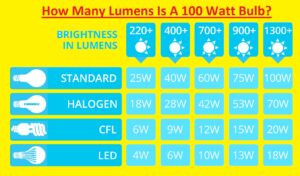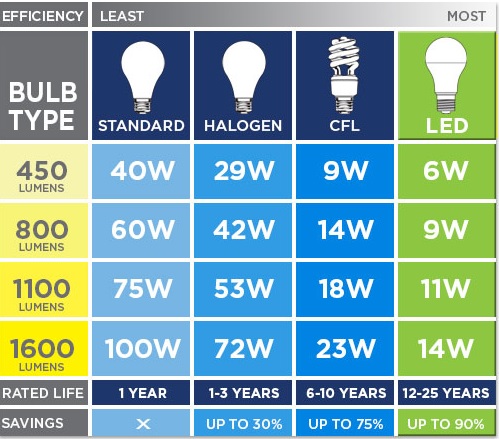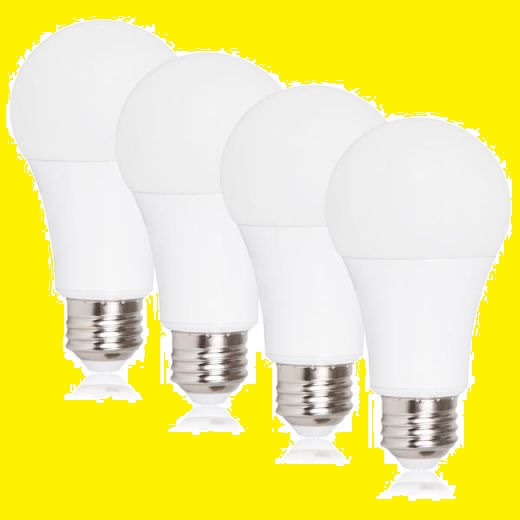Hello readers welcome to the new post. In this post, we will discuss How Many Lumens Is A 100-Watt Bulb? lighting, lumens, and watts are two mostly used terms that help understand the brightness and energy use of light bulbs. Lumens explain the brightness of the bulb and watts explain the power use. However, with the increase of energy-effective lighting systems like LED, the relation between lumens and watts has become complicated. Here we will learn how many lumen 100-watt bulbs are produced. So let’s get started with How Many Lumens Is A 100-Watt Bulb?
Introduction to Lumens100 Watt Bulb
Lighting is the main parameter in our electrical system and knowledge of the brightness level of different bulbs is important when choosing lighting options. In older days wastts were commonly used to measure the brightness. The use of energy-efficient light systems helps to find the relation between watts and brightness. To accurately define the bulb glows some parameters are needed
What’s a Lumen?
Lumens measure hoe much light we get from the bulb. high lumens means that it is brighter light, less lumens that light is dim.
In simple words, lumens are to light.
, lumens are a measurement of how bright a light source is. The high-lumen light source will be more bright. Lumerns is comparing between brightness of different light bulbs. The 100-watt incandescent bulb such as generated 1600 lumens of light. But 100-watt bulbs can be used in place of effective lED as alternative lumen output of 100-watt LED bulbs varies base don bulbs types. If there is a need to replace a 100-watt incandescent bulb select an LED bulb that generates a minimum of 1600 lumens. It uses less energy with gives similar light to an incandescent bulb.
| Light Bulb | Watts | Lumens |
|---|---|---|
| Incandescent | 100 | 1600 |
| CFL | 75 | 1100 |
| LED | 15 | 1000 |
Lumens vs. Watts: Understanding the Difference
| Light Bulb | Watts | Lumens |
|---|---|---|
| Incandescent | 40 | 450 |
| Incandescent | 60 | 800 |
| Incandescent | 100 | 1600 |
| CFL | 25 | 375 |
| CFL | 40 | 600 |
| CFL | 75 | 1100 |
| LED | 5 | 400 |
| LED | 10 | 800 |
| LED | 15 | 1000 |
| Lumens | Watts | Incandescent | Fluorescent | LED |
|---|---|---|---|---|
| 380-460 | 40 | 40 Watt | 9 Watt | 4 Watt |
| 1700-1800 | 100 | 100 Watt | 13 Watt | 7 Watt |
| 2600 | 150 | 150 Watt | 42 Watt | 25 Watt |
| 7000+ | 70 | – | – | 70 Watt |
How Many Lumens Does a 100-Watt Incandescent Bulb Produce?
How Many Lumens Does a 100-Watt LED Bulb Produce?
The relationship between watts and lumens is not set when it comes to LED lights. The lumen output of an LED bulb changes based on quality, design, and intended purpose. Though, a 100-watt LED bulb can generate about 1600 to 2000 lumens.
Factors Affecting Lumen Output
- luminous efficiency of LEDs,
- light transmittance of the lens,
- efficiency of the driver.
Choosing the Right Bulb: Lumens and Brightness
To choose the right bulb it is needed to consider the required brightness level of a certain area. Different areas can need different brightness based on requirements. Such as working areas can get advantages from high lumens to make sure large illumination and cozy rooms need softer high light
How to Convert Watts to Lumens
This formula for watt-to-lumens conversion
ΦV(lm) = P(W) × η(lm/W)
lumens = watts × (lumens per watt)
or
lm = W × (lm/W)
How many lumens is a 100-watt bulb
The lumen output of a 100-watt incandescent bulb is around 1600. The lumen output of a 100-watt LED bulb changes based on Cetina bulb type but normal 100-watt bulbs can see as outmoded and ineffective LED
| Light Bulb | Watts | Lumens |
|---|---|---|
| Incandescent | 100 | 1600 |
| CFL | 75 | 1100 |
| LED | 15 | 1000 |
100 WATT IN LUMENS
| Type of bulb | 200-300 lumens | 300-500 lumens | 500-700 lumens | 700-1000 lumens | 1000-1250 lumens | 1250-2000 lumens |
|---|---|---|---|---|---|---|
| Incandescent | 15-20 | 25-30 | 35-40 | 50-60 | 75-90 | 125-150 |
| Halogen | 18-25 | 35-50 | 60-75 | 90-120 | 150-180 | 225-300 |
| CFL | 5-6 | 8-11 | 13-15 | 18-20 | 25-30 | 40-50 |
| LED | 2-4 | 3-5 | 5-7 | 8-10 | 10-13 | 15-20 |
Lumen vs watt
The watt is the amount of energy the bulb uses and the lumen defines the amount of light released from the energy source.
In energy-effective bulbs, watts are lower to get the same number of lumens. Such as standard 60-watt bulb provides 500 to 700 lumens of light. Irrespective of how much power is needed using a bulb based on lumens is correct then use wattage.
Conventional lighting can define that high wattage means more light, it is not always followed. For more lighting go for bulbs with high lumens.
How to Convert Lumens to Watts
We can’t convert lumens directly to watts, as they measure. Lumners is a measurement of brightness and watts is the amount of power the source uses. We can measure lumens per watt of light source which is measuring its efficiency.
For measuring lumens for one att divide lumens by watts. Such as 60-watt incandescent bulb generates 800 lumens, so its lumens per watt is 800/60 = 13.3 lm/W.
Lumenrs value per watt of the light source used for compassion efficiency of differnt light sources. For explanation 10 wat LED light bulb generated a similar amount of light as 60 watt 60-watt incandescent bulb. it shows that lED bulb light t has lumens per watt of 800/10 = 80 lm/W, which is 6 times the effective incandescent bulb.
Here is the formula for measuring lumens per watt:
lumens per watt = lumens / watts
Examples
- Incandescent: 15 lm/W
- CFL: 50 lm/W
- LED: 75-110 lm/W
Light Wattages vs. Lumens Luminous Flux
There is no ideal light source that transforms 100 percent of energy in light, all light sources transform energy into light and some energy into heat. Based on the method energy efficiency of light sources changes.
How bright are 100 lumens?
The flashlight releases 100 lumens and office lighting fixtures release 2500 lumens. The normal 40-watt bulb releases 400 lumens of light. It means that we get 10 lumens per watt.
One lumner also liked the light output of one candle. So 100 lumen is used in urban and suburban places for scanning small areas, etc.
it is the best brightness for a 2x AA flashlight. The number of lumens we need for lighting will be based on the height of the ceiling, room size, and lumps used.
How many lumens is a 75 watt bulb?
-
- A 75 watt bulb genertes about 1100 lumens.
How many lumens is a 200-watt bulb?
-
- A 200-watt bulb produces about 1200 lumens.
How many lumens is a 150-watt bulb?
-
- A 150-watt bulb generates 2600 lumens.
How many lumens is a 120-watt bulb?
-
- A 120-watt bulb generates about 720 lumens.
How many lumens is an 80 watt bulb?
-
- An 80-watt bulb gives about 480 lumens.
How many lumens is a 40 watt bulb?
-
- A 40 watt bulb has 240 lumens.
10,000 lumens to watts
-
- 10,000 lumens is equivalent to about 150 watts.
How many lumens is a 300-watt bulb?
-
- A 300-watt bulb gives about 1800 lumens.
Is 100 lumens bright enough to light up a living room or backyard?
For basic households outdoors there is a need of 20 to 150 lumens. If there is about 100 meters backyard, use 160 to 200 lumens of light. Normally we can use 100 lumens to light the path about the house. With that, some other parameters such as sensor lights, and step lights are also considered.
With that check how dark or bright your backyard is. it helps to use lumens in-house. For finding the lumens find the square foot. For 100 sq feet areas, there is a need of 1000 to 200 lumens which is equal to ten to twenty feet. The 30 lumens is one square foot.
How many lumens are in a 100 watt LED bulb?
If a 100-watt LED bulb uses 100 watts it offers 10000 lumens. LED used for white light can make 100 lumens per watt.
Is 800 lumens bright?
The 800 lumens is the brightness of a single 60-watt incandescent light bulb. It is best for a walk-in closet but not enough since the only a light source in the habitable room.
What is the equivalent of a 100 watt bulb in LED?
| Lumens | Incandescent bulb | LED bulb |
|---|---|---|
| 75-110 | 9 watts | 1 watt |
| 730-800 | 60 watts | 7-9 watts |
| 1380-1600 | 100 watts | 12-14 watts |
| 2000-2500 | 150 watts | 28-23 watts |
How many lumens is a 60-watt bulb?
The conventional 60-watt bulb generated 800 lumens of light. Through comparison, we can find LED bulbs that generate the same 800 lumens and use only 9 watts.
How bright is 7000 lumens?
The 50-watt light bulb has lumens of about 800. The 7000 lumens will give the equivalent of a football field lit up with 100-watt light bulbs and is higher thatn needed for an average-sized room.
Can you replace 55W bulbs with 100W LED?
It is not recommended to change a 55-watt incandescent bulb with a 100-watt LED bulb, since LED bulbs are effective and release bright light for the same watt. The higher watt of LED bulbs can overload fixtures and electrical problems
How bright is 20,000 lumens?
20000 lumens is a high level of brightness, but it is best for outdoor lighting uses such as stadium light, larger parking lots, and outdoor occurrences.
Should I get 60w or 100W bulbs?
It will be safe if the bulb with wattage is equal to or less thatn the fixtures designed watt. It can be best to use for lower-wattage bulbs in high-wattage fixtures. Such as lower wattage bulb can provide a soft or dimmer light effect.
FAqs
What LED bulb is equivalent to 100 watts?
12 Watt led bulb is equal to 100 watts
How many lumens is a 60 watt bulb?
60-watt incandescent bulb produces about 800 lumens of light
How many lumens is full sunlight?
for each square meter, the sun provdies 127,000 lumens.
What is 1000 lumens in watts?
1000 lumens is equal to 10 watts.
Is 2000 lumens too bright?
2000 lumens is a good amount of light and is considered to be quite bright.
What is the highest lumen watt?
The highest lumens that can be produced by one watt of electrical power is 683
Is 10,000 lumens very bright?
Yes, 10,000 lumens is very bright. It has a brightness equal to that of a 100-watt incandescent bulb.
Is 20000 LED lumens bright?
Yes, 20000 LED lumens are bright. Its brightness is two 100-watt incandescent bulbs.
Are LED lumens brighter?
Yes, LED lumens are brighter than incandescent lumens. Since LEDs are more efficient at transforming electrical energy into light.
Are lumens brighter than Watts?
Lumens measure the total watt of light released by the bulb and watt is the amount of power used by the bulb. Watt does not define how bright bulbs and lumens do. It is best o estimate how bright an incandescent bulb high watt rating high light released
What is the difference between lumens and lux?
- Lumens: The total quantity of visible light released by the light source is lumens. Light source bright will have more lumens
- Lux: It is the amount of light that falls on the surface. Lumens of light t source distance between light source and surface and reflectivity of the surface all measure the lux level of a surface.
What is the color temperature of a light bulb?
Color temperature is a technique to define the light color provided by a light bulb. It is measured in degrees of Kelvin on a scale from 1000 to 10000. Normally Kelvin temperature for residential lighting applications exists on scales from 200k to 6500k
What is the CRI of a light bulb?
What are the different types of light bulbs?
- Ther are 4 types of light bulbs that are
- light-emitting diode (LED),
- compact fluorescent (CFL),
- incandescent,
- halogen.
What are the benefits of LED light bulbs?
- Long Life.
- Energy Efficiency.
- Ecologically Friendly
- Design Flexibility
- Durable Quality
- Zero UV Emissions
- Operational in Extremely Cold or Hot Temperatures
- Light Disbursement










